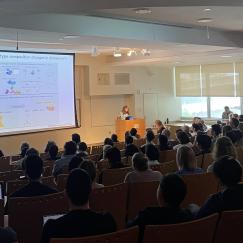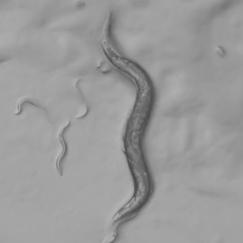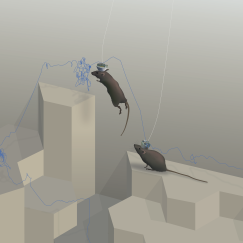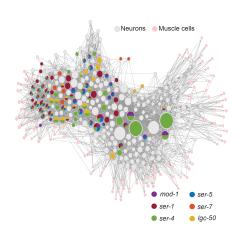Taking an audience of hundreds on a tour around the body, seven speakers at The Picower Institute for Learning and Memory’s symposium “Circuits of Survival and Homeostasis” Oct. 21 shared their advanced and novel research about some of the nervous system’s most evolutionarily ancient functions.
Introducing the symposium she arranged with a picture of a man at a campfire on a frigid day, Sara Prescott, assistant professor in The Picower Institute and MIT’s Departments of Biology and Brain and Cognitive Sciences, pointed out that the brain and the body cooperate constantly just to keep us going and that when the systems they maintain fail, the consequence is disease.
“[This man] is tightly regulating his blood pressure, glucose levels, his energy expenditure, inflammation and breathing rate, and he’s doing this in the face of a fluctuating external environment,” Prescott said. “Behind each of these processes there are networks of neurons that are working quietly in the background to maintain internal stability. And this is, of course, the brain’s oldest job.”
Indeed, though the discoveries they shared about the underlying neuroscience were new, the speakers each described experiences that are as timeless as they are familiar: the beating of the heart, the transition from hunger to satiety, and the healing of cuts on our skin.
Feeling warm and full
Li Ye, a scientist at Scripps Research, picked right up on the example of coping with the cold. Mammals need to maintain a consistent internal body temperature, and so they will increase metabolism in the cold and then, as energy supplies dwindle, seek out more food. His lab’s 2023 study identified the circuit, centered in the Xiphoid nucleus of the brain’s thalamus, that regulates this behavior by sensing prolonged cold exposure and energy consumption. Ye described other feeding mechanisms his lab is studying as well, including searching out the circuitry that regulates how long an animal will feed at a time. For instance, if you’re worried about predators finding you, it’s a bad idea to linger for a leisurely lunch.
Physiologist Zachary Knight of UC San Francisco also studies feeding and drinking behaviors. In particular, his lab asks how the brain knows when it’s time to stop. The conventional wisdom is that all that’s needed is a feeling of fullness coming from the gut, but his research shows there is more to the story. A 2023 study from his lab found a population of neurons in the caudal nucleus of the solitary tract in the brainstem that receive signals about ingestion and taste from the mouth, and that send that ‘stop eating’ signal. They also found a separate neural population in the brainstem that indeed receives fullness signals from the gut, and teaches the brain over time how much food leads to satisfaction. Both neuron types work together to regulate the pace of eating. His lab has continued to study how brainstem circuits regulate feeding using these multiple inputs.
Energy balance depends not only on how many calories come in, but also on how much energy is spent. When food is truly scarce, many animals will engage in a state of radically lowered metabolism called torpor (like hibernation), where body temperature plummets. The brain circuits that exert control over body temperature are another area of active research. In his talk, Harvard neurologist Clifford Saper described years of research in which his lab found neurons in the median preoptic nucleus that dictate this metabolic state. Recently, his lab demonstrated that the same neurons which regulate torpor also regulate fever during sickness. When the neurons are active, body temperature drops. When they are inhibited, fever ensues. Thus, the same neurons act as a two-way switch for body temperature in response to different threatening conditions.
Top of page: Li Ye delivers a talk on circuits that regulate the brain's feeding behavior.
Sickness, injury, and stress
As the idea of fever suggests, the body also has evolved circuits (that scientists are only now dissecting) to deal with sickness and injury.
Washington University neuroscientist Qin Liu described her research into the circuits governing coughing and sneezing, which, on one hand, can clear the upper airways of pathogens and obstructions but, on the other hand, can spread those pathogens to others in the community. She described her lab’s 2024 study in which her team pinpointed a population of neurons in the nasal passages that mediate sneezing and a different population of sensory neurons in the trachea that produce coughing. Identifying the specific cells and their unique characteristics makes them potentially viable drug targets.
While Liu tackled sickness, Harvard stem cell biologist Ya-Chieh Hsu discussed how neurons can reshape the body’s tissues during stress and injury, specifically the hair and skin. While it is common lore that stress can make your hair grey and fall out, Hsu’s lab has shown the actual physiological mechanisms that make it so. In 2020 her team showed that bursts of noradrenaline from the hyperactivation of nerves in the sympathetic nervous system kills the melanocyte stem cells that give hair its color. She described newer research indicating a similar mechanism may also make hair fall out by killing off cells at the base of hair follicles, releasing cellular debris and triggering auto-immunity. Her lab has also looked at how the nervous system influences skin healing after injury. For instance, while our skin may appear to heal after a cut because it closes up, many skin cell types actually don’t rebound (unless you’re still an embryo). By looking at the difference between embryos and post-birth mice, Hsu’s lab has traced the neural mechanisms that prevent fuller healing, identifying a role for cells called fibroblasts and the nervous system.
Continuing on the theme of stress, Caltech biologist Yuki Oka discussed a broad-scale project in his lab to develop a molecular and cellular atlas of the sympathetic nervous system, which innervates much of the body and famously produces its “fight or flight” responses. In work partly published last year, their journey touched on cells and circuits involved in functions ranging from salivation to secreting bile. Oka and co-authors made the case for the need to study the system more in a review paper earlier this year.
A new model to study human biology
In their search for the best ways to understand the circuits that govern survival and homeostasis, researchers often use rodents because they are genetically tractable, easy to house, and reproduce quickly, but Stanford biochemist Mark Krasnow has worked to develop a new model with many of those same traits but a closer genetic relationship to humans: the mouse lemur. In his talk, he described that work (which includes extensive field research in Madagascar) and focused on insights the mouse lemurs have helped him make into heart arrhythmias. After studying the genes and health of hundreds of mouse lemurs, his lab identified a family with “sick sinus syndrome,” an arrhythmia also seen in humans. In a preprint study his lab describes the specific molecular pathways at fault in disrupting the heart’s natural pace making.
By sharing some of the latest research into how the brain and body work to stay healthy, the symposium’s speakers highlighted the most current thinking about the nervous system’s most primal purposes.








